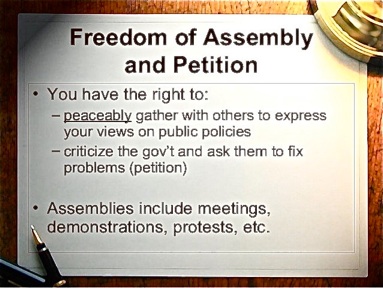The Right to Assemble and Petition

Those with tears had laid their lives on the line on foreign battlefields, in factories rolling out tanks and planes, or in homes with flags of blue and gold stars in their front windows. They gave their all to preserve the land of the free.
They fought to preserve the government of the people, by the people, and for the people. Now, though, pictures of the capitol project an image of a third world dictatorship walling itself away from the people who fight to keep it open and free.
Some will rush forward now and try to explain that the fence around the capitol is an insult to some Americans just exercising their rights as free men. The guards inside the fence are there to suppress rights guaranteed by the Constitution. They are there to deny Americans their rights of free speech, assembly, and petition guaranteed by the First Amendment to the Constitution.
In making that argument, they conveniently leave out three important words of that amendment. The pertinent parts of the First Amendment are: “Congress shall make no law…prohibiting…the right of the people peaceably to assemble, and to petition the Government for a redress of grievances.”
The most recent examples of abusing those rights is the Trump riot on January 6. That unbelievable attempt to ignore or destroy the will of the people expressed in their votes is what led to the fences and armed guards around the people’s house. On TV, the storming of the capitol and confrontations with police appeared to be coming from a country where a dictator was ordering his supporters to protect his office.
Unfortunately, that abuse of our right to assemble and petition is just the most recent example of assemblages turning violent. The early Black Lives Matter marches, the continuing unrest in Portland, Oregon, and demonstrations over the George Floyd murder are merely a few of the assemblies to petition becoming violent mobs.
That trend toward demonstrations that result in property damage and deaths has to be stopped.
A baby step has been taken in that direction with the indictments of some of the capitol invaders and the continuing investigations to identify more of the perpetrators.
But what about the future?
The precedent of demonstrations turning violent has been set. So prepare for a continuing stream of similar violent encounters.
Reversing or stopping that trend toward violent demonstrations will not be easy. Among several choices for calming these building storm clouds is having the media and public officials change their coverage of such events.
Coverage of such events should concentrate exclusively on the assaults, murder, and property damage, not on the purported grievance that prompted the gathering. If any participant is to be interviewed, it should be one in the middle near the back of the pack, not one of the leaders with a bull horn.
A more effective step would be a law, preferably at the federal level, with two specific provisions.
One would be to require a permit for any gathering of more than ten unrelated individuals for an “assembly.” The application for the permit would have to state with specificity the exact purpose of the assembly.
The other would provide that any act of violence by any individual in the assembly would make the entire assembly illegal and subject every participant to arrest and prosecution.
So here’s the perspective.
This abuse of our right to assemble and to petition the government for a redress of our grievances has to stop. In trying to stop it, however, we must be careful to not react to the abuse in any way that resembles the actions of the leaders in North Korea, China, Iran, and other dictatorships.
Is there a better solution than changing the way demonstrations are now headlined and tightening the law on demonstrations?
Let’s hear about them.
enough





